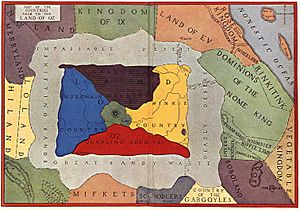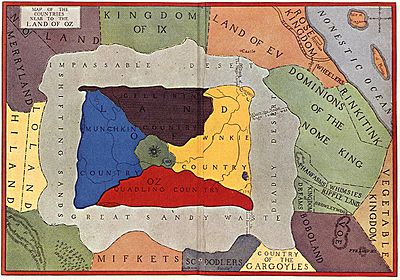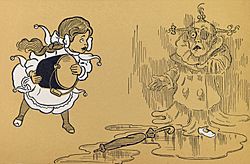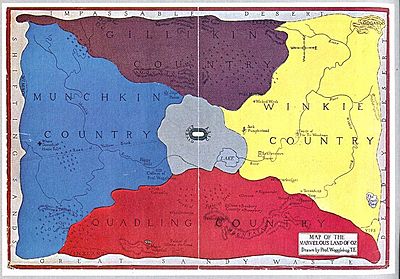Land of Oz facts for kids
Quick facts for kids Oz |
|
|---|---|

The official map of Oz and its neighbouring kingdoms. The regions beyond Oz's surrounding deserts were introduced after the first Oz book.
|
|

Flag of Oz
|
|
| Oz books location | |
| Other name(s) | Land of Oz |
| Created by | L. Frank Baum |
| Genre | Fantasy |
| Type | Fairy country |
| Ruler | Princess Ozma |
| Ethnic group(s) | Munchkins, Winkies, Quadlings, Gillikins |
| Notable locations | Emerald City (capital), Munchkin Country, Gillikin Country, Quadling Country, Winkie Country, Yellow brick road, Deadly Desert |
| Population | 1,000,000,000 |
| First appearance | The Wonderful Wizard of Oz |
| Anthem | "The Oz Spangled Banner" |
| Language | English |
| Currency | none |
The Land of Oz is a magical country that first appeared in the famous children's book The Wonderful Wizard of Oz. This book was written by L. Frank Baum in 1900.
Oz is divided into four large areas: the Gillikin Country in the north, Quadling Country in the south, Munchkin Country in the east, and Winkie Country in the west. Each area has its own leader. However, the entire Land of Oz is ruled by one main monarch. After the second Oz book, The Marvelous Land of Oz, this ruler became Princess Ozma.
L. Frank Baum didn't originally plan to write more Oz books. But The Wonderful Wizard of Oz became super popular! Because of its huge success, Baum decided to write more stories about Oz. For the next 20 years, he kept writing and adding to the world of Oz in a series called the Oz Books. He even called himself the "Royal Historian of Oz."
Baum wrote 14 best-selling children's books about Oz. After he passed away in 1919, other writers and artists continued the series. Today, there are over 50 novels based on Baum's original Oz stories.
In the Oz books, Baum described Oz as a real place. This is different from the 1939 movie The Wizard of Oz, where it seems like a dream. According to the books, Oz is a hidden fairyland. It's cut off from the rest of the world by a dangerous place called the Deadly Desert. People from Oz are called "Ozites" or "Ozmie."
Contents
What Makes Oz Special?
In the first book, The Wonderful Wizard of Oz, Oz is different from Dorothy's home in Kansas because it's a magical place. Kansas doesn't have witches and wizards, but Oz does! In the third book, Ozma of Oz, Oz is called a "fairy country." This new name helped explain all the amazing things that happen there.
Exploring the Land of Oz
Oz is shaped like a rectangle. It's divided into four main countries: Munchkin Country in the East, Winkie Country in the West, Gillikin Country in the North, and Quadling Country in the South. Right in the middle of Oz is the famous Emerald City. This is the capital of Oz and where Princess Ozma lives and rules.
Each region in Oz has its own special color:
- Blue for the Munchkins
- Yellow for the Winkies
- Red for the Quadlings
- Purple for the Gillikins (this color was added in later books)
- Green for the Emerald City
In the first book, these colors were mostly for clothes and buildings. But in later books, sometimes the plants and even the mud would be the color of the region! Baum didn't always use the colors strictly, but they helped readers know where the characters were.
Most parts of Oz are filled with happy and successful people. However, some areas are cut off from the main culture. Many people in these areas have never even heard of Ozma! These hidden places are often where new adventures happen in the Oz books. For example, The Lost Princess of Oz takes place in a wild part of Winkie Country.
A famous yellow brick road leads from Munchkin Country to the Emerald City. Other yellow brick roads appeared in later books, like one from Gillikin Country.
Oz is completely surrounded by a desert. This desert keeps the people of Oz safe from outsiders. In the first two books, it was just a big, dangerous desert. But in The Road to Oz, it became a magical place called the Deadly Desert. Anyone who touches its sands is said to turn into sand! This desert makes it very hard for people from the outside world to get into Oz.
Even with the desert, people have found ways into Oz. Children from our world, the Wizard himself, and even bad guys like the Nome King have crossed it. After one attempt by the Nome King, Glinda created an invisibility barrier around Oz for even more protection. Even though people still found ways in, this magical barrier stayed in place.
West and East
The first map of Oz showed the blue Munchkin land in the east and the yellow Winkie land in the west. This matches what Baum wrote in his books. For example, the Wicked Witch of the East ruled the Munchkins, and the Wicked Witch of the West ruled the Winkies.
However, some maps of Oz printed in books had the directions mixed up. This might have happened because of how the maps were copied. It has caused some confusion over the years!
Where is Oz Located?
Baum always said Oz was a real place, just hidden from the rest of the world. It gradually gained magical neighboring countries, like Ev and Mo.

In Tik-Tok of Oz, maps showed Oz on a continent with its neighbors. This continent is sometimes called Nonestica. It's located in the Nonestic Ocean. Many clues in the books suggest this continent is somewhere in the southern Pacific Ocean. For instance, Dorothy Gale was sailing to Australia when she was washed overboard and landed near Oz. Also, palm trees grow in the Emerald City, and horses are not native to Oz, which fits a South Pacific location.
However, some things don't quite fit. The seasons in Oz are the same as in the United States. Also, in The Wishing Horse of Oz, a character follows the North Star, which you can only see in the Northern Hemisphere. So, its exact location is a bit of a mystery!
What Inspired Oz?
Baum might have been inspired to create the Emerald City by the White City at the World's Columbian Exposition in Chicago, which he visited often. This huge fair was built very quickly, just like the Emerald City in the first book.
Oz is also a bit like the United States:
- The Emerald City is like Chicago in the middle.
- To the East, there are forests and farms.
- To the West, there are flat plains.
- To the South, it's warm with lush plants and red soil.
Witches and Wizards

When The Wonderful Wizard of Oz begins, each of the four lands in Oz is ruled by a Witch. The Witches of the North and South are good, while the Witches of the East and West are wicked. Glinda (the Good Witch of the South) is the most powerful.
After Dorothy's house lands on the Wicked Witch of the East, the Good Witch of the North tells Dorothy that Oz still has witches and wizards because it's not "civilized." She explains that witches can be good or evil.
Baum usually capitalized "Witch" when talking about the specific Witches of the North, South, East, or West. But he used a lowercase "witch" when talking about witches in general.
White is the traditional color for good witches in Oz. The Good Witch of the North wears a white hat and gown. Glinda, the Good Witch of the South, wears a pure white dress. Dorothy is even mistaken for a witch because her dress is blue and white!
Once Ozma becomes queen, she limits who can use magic. Only Glinda, the Wizard of Oz, and Ozma herself are allowed to use magic. But bad guys in later books often try to use magic illegally.
Amazing Animals of Oz
In Oz, all animals can talk because it's a "fairy" kingdom. Dorothy's dog, Toto, doesn't talk at first, but Baum later said he could talk, he just chose not to! He finally speaks in Tik-Tok of Oz.
Here are some of the many animals living in Oz:
- Cowardly Lion – One of Dorothy Gale's best friends.
- Dragons – The toughest creatures in Oz. Some live underground in Gillikin Country.
- Field Mice – Tiny mice who helped Dorothy and her friends escape a poppy field.
- Glass Cat – A cat made of glass that was brought to life by magic.
- Gump – A creature like an elk with big antlers.
- Hungry Tiger – The Cowardly Lion's best friend. He's always hungry but never eats anyone!
- Kabumpo – A very fancy elephant from the land of Pumperdink.
- Kalidahs – Scary creatures with the head of a tiger and the body of a bear.
- Orks – Flying animals that look like a mix of an ostrich and a parrot.
- Rak – A huge, terrible beast that can eat anything.
- Winged Monkeys – Monkeys with bird wings who obey the owner of a special Golden Cap.
- Wise Donkey – A smart donkey who gives advice.
Other People of Oz
Many other unique groups of people live in Oz. Most of them only appear in one book. Here are a few:
- The China People – Beings made of china (like porcelain dolls) who live in Quadling Country.
- The Flatheads – Humans with flat heads who carry their brains in cans.
- The Fuddles – People who look like jigsaw puzzles and live in Fuddlecumjig.
- The Hammerheads – Armless people with long, stretchy necks and hard heads.
- The Hoopers – 10-foot-tall humanoids who can roll into hoops.
- The Hyups – A group of Munchkins who live on Mount Munch.
- The Magical Mimics – Evil shape-shifting creatures.
- The Skeezers – Normal humans who often fight with the Flatheads.
- The Utensians – Living utensils who live in Utensia.
Many characters in Oz are also animated objects, like the Scarecrow, Jack Pumpkinhead, and the Sawhorse. There are even whole regions where everyone is an animated being! Oz is a very accepting place for all kinds of unique people and creatures.
How Oz is Governed
Some people think Oz is like a socialist utopia, a perfect society. This is because in The Emerald City of Oz, it says:
"There were no poor people in the land of Oz because there was no such thing as money... Each person was given freely by his neighbors whatever he required... Every one worked half the time and played half the time..."
However, in the first two books, people in Oz did use money, like "green pennies." Later, Baum decided to remove money from the idea of Oz. This might have been because Baum himself had money problems when he was writing the books.
Since Oz is ruled by a monarch (a queen), Princess Ozma, it's more like an absolute monarchy than a communist state. Ozma is the main ruler, but there are also individual kings and queens in the smaller regions.
Oz has always been a very rich and colorful country, especially compared to Dorothy's gray Kansas.
The Royal Flag of Oz shows a map of the land. The four colors represent the four countries, and the green star represents the Emerald City.
Protecting Oz
Oz is mostly a peaceful land, and its people don't really understand fighting. This has caused problems, like when the Emerald City was easily taken over by an "Army of Revolt" led by General Jinjur. The city was only guarded by an old doorman and one soldier!
Oz is mostly protected by magic. Glinda's spell makes Oz completely invisible to outsiders. The Deadly Desert also acts as a natural barrier. The Nome King has tried to conquer Oz many times, but he always fails, usually because of Ozma or her friends.
In the movie Return to Oz, the mechanical man Tik-Tok is the entire Royal Army of Oz!
Main Characters of Oz
Here are some of the most important characters in the classic Oz series:
- Dorothy Gale – A brave little orphan girl from Kansas. She visits Oz many times and eventually moves there permanently. Dorothy becomes best friends with Princess Ozma and is named an official princess of Oz.
- Toto – Dorothy's loyal little black dog. He follows Dorothy on most of her adventures.
- Princess Ozma – The rightful queen of Oz. She is the daughter of Oz's last king, Pastoria, who ruled before the Wizard. Ozma becomes queen after The Wonderful Wizard of Oz.
- Uncle Henry – Dorothy's uncle, a farmer from Kansas. He and Aunt Em eventually move to Oz with Dorothy.
- Aunt Em – Dorothy's aunt and Uncle Henry's wife. She also moves to Oz.
- The Good Witch of the North – The kind ruler of the northern Gillikins. She was the first witch Dorothy met in Oz.
- The Scarecrow – A living man made of straw, and a good friend of Dorothy. He was briefly King of Oz before Ozma was found.
- The Tin Woodman – An enchanted woodsman made of tin, and another good friend of Dorothy. He is now the Emperor of the western Winkies.
- The Cowardly Lion – A talking lion who is a good friend of Dorothy. He overcomes his fear and becomes King of the Beasts.
- The Wizard (Oscar Diggs) – The former ruler of Oz. He was a circus entertainer from Nebraska who used tricks to seem powerful. Now, he's a real wizard after learning from Ozma and Glinda.
- Glinda – The beautiful and wise Good Witch of the South. She rules the southern Quadlings from her ruby palace.
- Jack Pumpkinhead – A man made of wooden branches with a pumpkin for a head, brought to life by magic.
- The Sawhorse – An animated sawhorse who becomes a trusty steed for Ozma.
- Tik-Tok – A mechanical, super-intelligent clockwork robot.
- The Shaggy Man – A friendly, homeless man from the "real world" who moves to Oz.
- The Patchwork Girl (Scraps) – A living doll made of colorful fabric, brought to life by magic. She becomes a friend of the Scarecrow.
- The Nome King – The main bad guy in the Oz books. He lives in the neighboring Nome Kingdom and often tries to conquer Oz.
Magic in Oz
Oz is full of magic! Many magical items play important roles in the stories.
Silver Shoes / Ruby Slippers
When Dorothy leaves Oz, she is carried home by the magical Silver Shoes. She got them after her house landed on the Wicked Witch of the East, who owned them before. Dorothy clicks her heels three times and wishes to go home. The shoes fall off in the desert and are never found again.
In the 1939 movie, the shoes are changed to Ruby Slippers. Dorothy clicks her heels and says, "There's no place like home." She then wakes up in Kansas, thinking it was all a dream.
Powder of Life
The Powder of Life is a magical substance that brings objects to life. It first appears in The Marvelous Land of Oz. A witch named Mombi got it from a "crooked magician." Later, it's revealed that a Dr. Pipt makes it. It takes six years to make just a few grains of this powder! It's always kept in a small "pepper box."
The Powder of Life was used to bring Jack Pumpkinhead, the Sawhorse, and the Gump to life. In The Patchwork Girl of Oz, it brings the Patchwork Girl, a glass cat, and a phonograph to life.
Magic Belt
The Magic Belt first appears in Ozma of Oz. It originally belonged to the Nome King, but Dorothy Gale stole it from him. When Dorothy leaves Oz, she gives it to Princess Ozma to keep safe.
The Magic Belt gives its wearer amazing powers:
- It can change anyone into any form.
- It can transport anyone anywhere.
- It makes the wearer safe from harm.
- Sometimes, it can even grant wishes!
Magic Picture
In Ozma's room, there's a special picture in a frame. It usually shows a nice countryside scene. But if someone wishes for it to show a certain person or place, the picture will show exactly that! Sometimes, you can even hear sounds from the picture.
Great Book of Records
Glinda's Great Book of Records is a magical book that records everything that happens in the world. As soon as something takes place, it appears in the book. This helps Glinda stay informed. The book is very useful, but villains often try to steal it!
The Love Magnet
This is a rusty horseshoe magnet that makes everyone love its owner. It belongs to the Shaggy Man. In The Road to Oz, he finds that being loved by everyone can sometimes be a problem! Ozma later changed its powers so it only works when it's displayed. She hangs it over the gate to the Emerald City so that everyone who enters will come with love.
Magic Fan
The Magic Fan was brought to Oz by Dorothy in The Royal Book of Oz. It can create a very strong wind, powerful enough to blow away an entire army!
Fountain of Oblivion
This fountain is in the Emerald City. Anyone who drinks from it forgets everything they know, even their own name! It was created by Glinda to help a wicked king forget his bad ways.
Magic Dinner Bell
This bell was created by the Red Jinn. When you ring it, a slave named Ginger appears with a tray full of delicious food. The bell can also help people escape danger. If you hold onto Ginger when he disappears after bringing food, you'll be transported with him to the Red Jinn's castle!
Other Facts About Oz
Death in Oz
In the later Oz books, it's said that no one can truly die in the Land of Oz. Baum wrote:
"No disease of any sort was ever known among the Ozites, and so no one ever died unless he met with an accident that prevented him from living."
This means that even if someone is chopped into pieces or melted, they would still be alive and aware. Also, a spell in Oz prevents anyone from aging. So, babies stay babies forever, and people stay the age they were when the spell took effect.
Talking Animals
In Oz, animals like the Cowardly Lion and the Hungry Tiger can talk. All animals native to Oz seem to be able to speak.
However, animals from outside Oz sometimes can't talk at first. Dorothy's dog Toto didn't speak in the first book, but Baum later said he always could, he just chose not to. Other animals, like the chicken Billina and the kitten Eureka, gained the ability to speak just by arriving in the magical lands near Oz.
Where Did the Name Oz Come From?
There's a story that L. Frank Baum's niece asked him the name of his magical land. He supposedly looked at a filing cabinet with drawers labeled A-G, H-N, and O-Z, and picked "Oz." His wife, however, said the part about the filing cabinet wasn't true.
In Dorothy and the Wizard in Oz, the name "Oz" is said to mean "great and good." Some people also think "Oz" might be short for "ounce," linking it to ideas about money in America at the time.
Another idea is that "Oz" comes from "Ozark Plateau" in the United States, where some of Baum's other fairy stories took place.
It's also possible that "Oz" comes from "Oz" as a nickname for Australia. Australia is a large continent with many deserts and green areas, which sounds a bit like Oz. However, the nickname "Oz" for Australia wasn't widely used until after the first book was published.
Legacy
In 2018, a project called "The Lost Art of Oz" began. Its goal is to find and catalog all the original artwork created by artists like John R. Neill and W.W. Denslow for the Oz book series.
Images for kids



